The Restoration Period, broadly spanning through the 17th century, was written after the restoration of the monarchy in 1660 following the period of the Commonwealth. To understand this period, we must also understand how the Jacobean Era began at the start of the 17th century and how the English Civil War led to major political transformations.
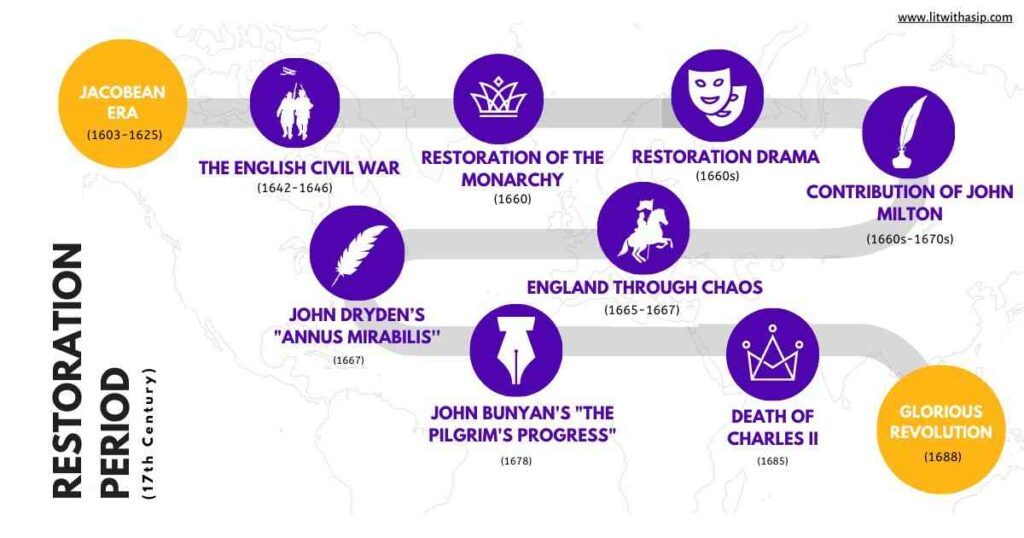
The Restoration Era also saw religious tensions, warfare, and the emergence of new scientific and philosophical ideas. This article presents the complete timeline in an easy-to-understand manner. Do read it till the end to get the complete picture:
Background of Jacobean Era (1603-1625)
From the beginning of the 17th Century, a sudden darkening of tone became noticeable in most forms of literary expression, especially in drama. For instance, Shakespeare’s work which was mostly comic and romantic turned to tragedy due to the upheaval caused by Queen Elizabeth’s death (1603) that marked the end of the Elizabethan Age (1558 to 1603) as well as of the Tudor Dynasty. The period from 1603 to 1625, known as the Jacobean Era, was marked by the reign of the new monarch, King James I. He was the first Stuart King of England and had styled himself to be called the “King of Great Britain”.
Some of the literary developments that took place during this era included drama, poetry, and prose. Playwrights like William Shakespeare, Ben Jonson, John Webster, and Thomas Middleton were active during this period. Plays of the Jacobean era often explored themes of power, ambition, revenge, and moral ambiguity. Shakespeare’s “Macbeth”, Jonson’s “Volpone”, Webster’s “The Duchess of Malfi”, and Middleton’s “The Changeling” are some of the notable works of the Jacobean Age.
The Jacobean era saw the rise of new poetic voices like John Donne, George Herbert, and Ben Jonson. Donne’s metaphysical poetries, characterized by its intellectual and often complex exploration of themes like love, religion, and mortality, were particularly influential. Also, the translation through the publication of the King James Version of the Bible (1611), commissioned by King James I, had a profound impact on English prose style and language.
The Jacobean era ended with the death of King James I of England in 1625. His son, Charles I, succeeded him to the throne, marking the transition from the Jacobean era to the Caroline era. The Caroline era encompasses the reigns of Charles I (1625–1649) and the Interregnum period during the English Civil War (1649–1660), leading into the subsequent Restoration period with the return of the monarchy under Charles II in 1660.
The English Civil War (1642-1646)
The year 1642 in England witnessed a series of civil wars and political conflicts between the Royalists and the Roundheads.

Royalists were people who supported King Charles I and Roundheads were the supporters of the Parliament of England. The major reasons believed to have led to these events are political, religious, and social tensions that had been building up in England for decades. Some of the major causes of these are:
- Charles I, whose reign spanned from 1625 to 1649, did not call for a parliament for over a decade after it was dissolved in 1629. He attempted to govern through prerogative powers and raising funds through non-Parliamentary means, ultimately giving rise to Personal Rule or the Eleven Years’ Tyranny.
- Charles I’s financial mismanagement was criticized and reprimanded as he imposed various taxes and fees, and levied extending ship money, a tax which was otherwise traditionally levied on coastal areas for defense. This gave way to resentment and suspicion among Parliamentarians (or, the Roundheads) sideline because of the King’s autocratic rule.
- Charles I also imposed religious conformity through his policies. Protestantism, which was already popular, found it suspicious when he married a Catholic princess, Henrietta Maria.
- In 1639, Charles I also attempted to impose an Anglican-style Prayer Book on Scotland’s Presbyterian Church. This led to an outburst among the religious community or clergy called the “First Bishops’ War”. Subsequent clashes like the Wars of the Three Kingdoms stained relations between Charles I and his Scottish subjects.
- Parliamentarians sought to have their right to participate in governmental affairs back. It led to a war named “First English Civil War” (1642–1646) which ended with the defeat of the Royalists in 1646 and led Charles I into custody.
- The Second English Civil War (1648–1649) is another event wherein the Royalists experienced one more defeat. It also resulted in the execution of Charles I in 1649, giving way to the establishment of the Commonwealth of England, a political unit that replaced the Kingdom of England.
Restoration of Monarchy (1660)
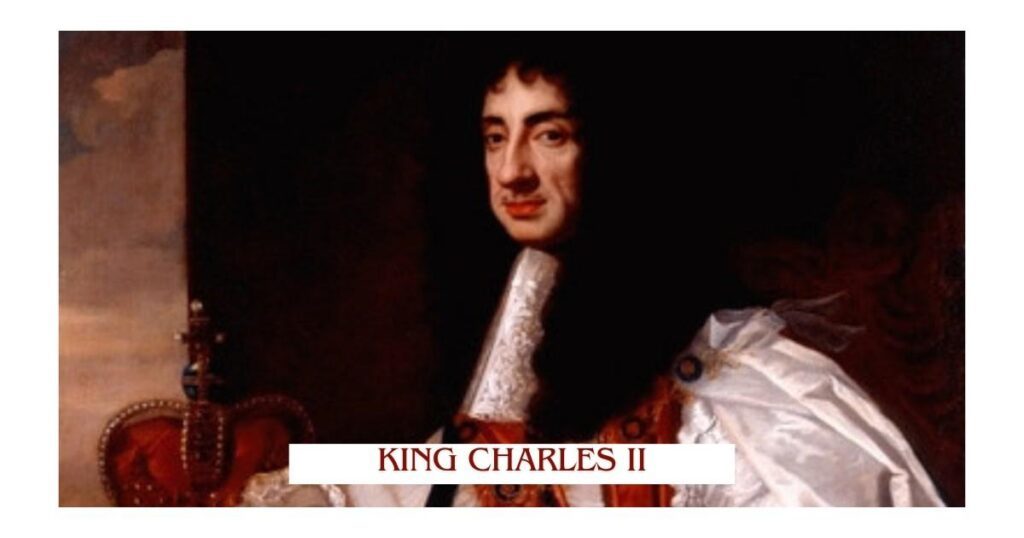
After the English Civil War and the co-existing period of the Commonwealth, Charles II was restored to the throne as King of England as well as of Scotland and Ireland. This took place under Oliver Cromwell, an English statesman, politician, and soldier, and during the Interregnum, a term used to describe the interval between two reigns when a throne is vacant.
Charles II’s return accompanied power-sharing and religious tolerance, enabling restoration and bringing a halt to the Interregnum. His policies were quite different from those of his father and heralded the return of the Stuart Monarchy.
The Indemnity and Oblivion Act, passed by the English Parliament after the Restoration of the monarchy in 1660, indeed provided a general pardon for most individuals who had committed crimes at the time of the English Civil War and the Commonwealth period. However, as you mentioned, certain serious crimes were excluded from the pardon, including murder, rape, piracy, buggery, and witchcraft. Additionally, individuals directly involved in the regicide of King Charles I were not granted amnesty.
The Act was designed to promote reconciliation and stability in the aftermath of the Civil War and to allow the country to move forward under the restored monarchy of Charles II. It aimed to provide a degree of closure to the past conflicts while also ensuring accountability for the most serious offenses committed during the turbulent period of the Civil War and Interregnum.
Restoration Drama (1660s)
The restoration of the monarchy also led to the coming back of theaters. The theaters that were closed during the Interregnum due to puritanical influence, political instability, moral concerns, and various economic factors, reopened. This vibrant period of dramatic production came to be known as Restoration Drama.
Playwrights like William Wycherley, George Etherege, and John Dryden contributed to the Restoration Drama through their witty and satirical comedies known as “Restoration comedies”. The themes often centered around love, sex, and social manners in these comedies. Some of the most important works included Aphra Behn’s “The Rover”, William Congreve’s “The Way of the World”, William Wycherley’s “The Country Wife”, George Etherege’s “The Man of Mode”, and John Vanbrugh’s “The Provoked Wife”.
Contribution of John Milton (1660s-1670s)
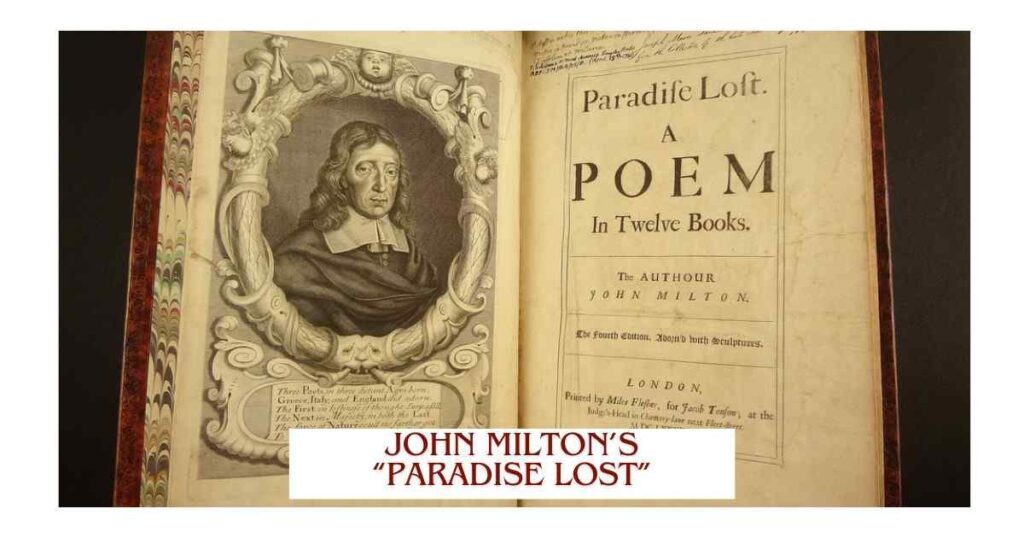
John Milton, one of the most renowned English poets, who was also a civil servant, is widely recognized for his contributions to literature during the uproarious period of the 1660s to 1670s in England. Serving as a literary central figure through the chaotic time of Stuart rulership, Milton is best regarded for his magnum opus “Paradise Lost” (1667), a blank verse epic poem showcasing the biblical story of the fall of man. It talks about how the first humans ever made by God, Adam and Eve, are tempted by Satan, the fallen angel leading them to be exempted from the Garden of Eden and hence, leading to the fall of humanity forever.
After “Paradise Lost”, Milton continued to write during the Restoration period and published works such as “Paradise Regained” (1671) and “Samson Agonistes” (1671). While the former portrays Jesus Christ’s resisting temptation in the wilderness and thus leading humankind’s way back to assimilation with God, the latter deals with the biblical figure of Samson and his ultimate betrayal by his lover, Delilah. These works very well reflected Milton’s political and religious views in the Restoration as well as the post-Restoration era.
His earlier contributions also included Areopagitica (1644) wherein, in the form of a powerful polemic speech, Milton traces the history of censorship and defends one’s freedom of speech and expression. His desire for freedom of expression was evident through his works where he became the first one to employ unrhymed verse, leaving a legacy and influence on poets like William Blake, William Wordsworth, and Thomas Hardy. His political views also left a lasting impact on following generations and his works are still referenced across various fields of studies.
England Through Chaos (1665 to 1667)
A conflict between England and the Dutch Republic over trade, colonial territories, and maritime supremacy called “The Second Anglo-Dutch War” erupted in 1665 and lasted till 1667. Amidst ongoing tensions between the two maritime powers resulted in a series of naval battles and skirmishes, including the celebrated Four Days’ Battle and the Raid on the Medway.
Despite initial English victories, including the capture of Dutch colonies, the war ended inconclusively with the Treaty of Breda (1667), which largely restored the status quo ante bellum. The war highlighted the challenges of maintaining dominance at sea and underscored the strategic importance of maritime trade and colonial possessions in the evolving geopolitical landscape of the 17th century.
Secondly, the Great Plague of London, which struck in 1665-1666, was one of the deadliest outbreaks of bubonic plague in England’s history. It caused the loss of an estimated 100,000 lives, killing the population and causing widespread fear and panic. The disease spread rapidly through the crowded streets of London, staggering the medical resources and leading to mass burials in plague pits.
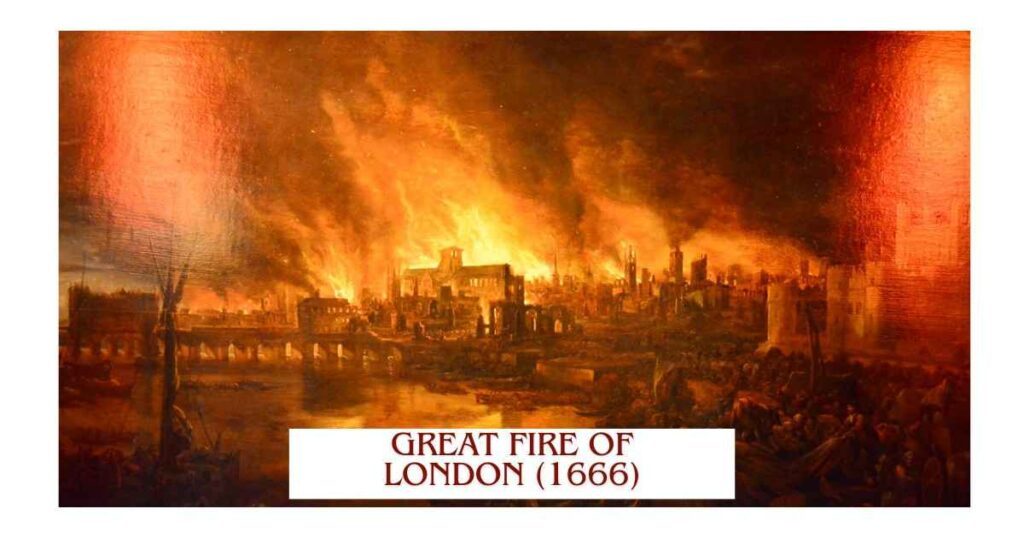
Following closely on the heels of the plague, the Great Fire of London erupted in September 1666, devastating the city even further. The cause was 1666 being a very hot year for London where there was a lack of rain for 10 months together, turning everything dry and easy to catch fire.
The Great Fire of London raged for four consecutive days, consuming thousands of homes and landmarks, including St. Paul’s Cathedral, today the seat of the bishop of London. The disaster left thousands homeless and caused great economic and social chaos.
Together, the Great Plague and the Great Fire of London profoundly impacted the city, leaving a lasting impact on England’s history. Despite the devastation, Londoners practiced resilience and rebuilt their city, leading to a period of reconstruction and renewal after these calamities.
John Dryden’s “Annus Mirabilis” (1667)
In 1667, John Dryden published his long poem “Annus Mirabilis”, commemorating the events of the year 1666, including the Great Fire of London and the Second Anglo-Dutch War. It portrays Dryden’s skillful use of language and verse, as well as his ability to blend historical narrative with political commentary and nationalistic fervor.
“Annus Mirabilis” reflects the spirit of resilience and renewal in the aftermath of adversity, while also celebrating the triumphs and challenges of the English nation. Dryden’s “Annus Mirabilis” exemplifies his mastery of poetic form and his engagement with contemporary events, cementing his reputation as a leading literary figure of the Restoration Era.
John Bunyan’s “The Pilgrim’s Progress” (1678)
A key literary work of the Restoration Erais John Bunyan’s “The Pilgrim’s Progress”, an allegorical novel published in 1678. It is one of the most popular and enduring works of English literature that comes under the tag of “theological fiction” including the Christian narrative aspect, describing a symbolic vision of a man’s journey through life. It incorporates Puritan themes and spirituality, resonating with a broader Restoration audience.
The “Pilgrimage” as reflected in the title is taken by the protagonist, Christian, who takes on a spiritual quest from the City of Destruction to the Celestial City. Throughout this journey, Christian faces various trials and temptations and confronts various characters representing different strands of the Christian life.
It must be noted that the significance of “The Pilgrim’s Progress” extends beyond the Restoration Era. This is because it is rich in spiritual and moral allegory, reflecting the religious and philosophical debates of Bunyan’s time. Its impact can be seen in subsequent religious and allegorical literature, as well as in the development of the English novel as a literary form.
It has been translated into numerous languages and adapted into various forms, including plays, films, and children’s books. Its enduring popularity attests to its timeless appeal and enduring relevance.
Death of Charles II (1685)
King Charles II died in 1685, after a brief illness at the age of 54. His death was attributed to apoplexy and his brother James II ascended to the throne amidst lingering political uncertainty and the specter of religious conflict.
Glorious Revolution (1688)
After a brief period of 3 years, the Glorious Revolution took place in 1688 wherein James II was overthrown and William III and Mary II were invited to rule as joint monarchs. This event marks the end of the Restoration period and the beginning of the subsequent Augustan Age in English literature.
William III and Mary II began their reign and the ethos of courtly and urban fashion was a result of sober, Protestant, and pious living contrasted with the sexually and intellectually uninhibited atmosphere of court life during Charles II’s reign. Typical literary forms in this period included novels, biography, history, travel writing, and journalism along with new scientific discoveries, philosophical concepts, and new social and economic conditions.
Overall, the end of the Restoration Erain literature marked a transition to a new era characterized by changing political, cultural, and literary dynamics. While the Restoration Era left a lasting legacy in English literature, the Glorious Revolution and its aftermath ushered in a new chapter in literary history, setting the stage for the literary achievements of the Augustan Age.

Jennis Jacob, a passionate literary enthusiast in her 20s, is a writer and poet. With eight years of experience in literature, she is currently a master in English and finds inspiration in Womanist, American, and Indian Partition Literatures. Her works have appeared in anthologies such as ‘Carved Words Of Creative Minds’ and ‘100 Splendid Voices,’ and she is working on upcoming books. Through LitWithASip, she aims to ignite a love for literature and empower individuals to embrace their true selves.

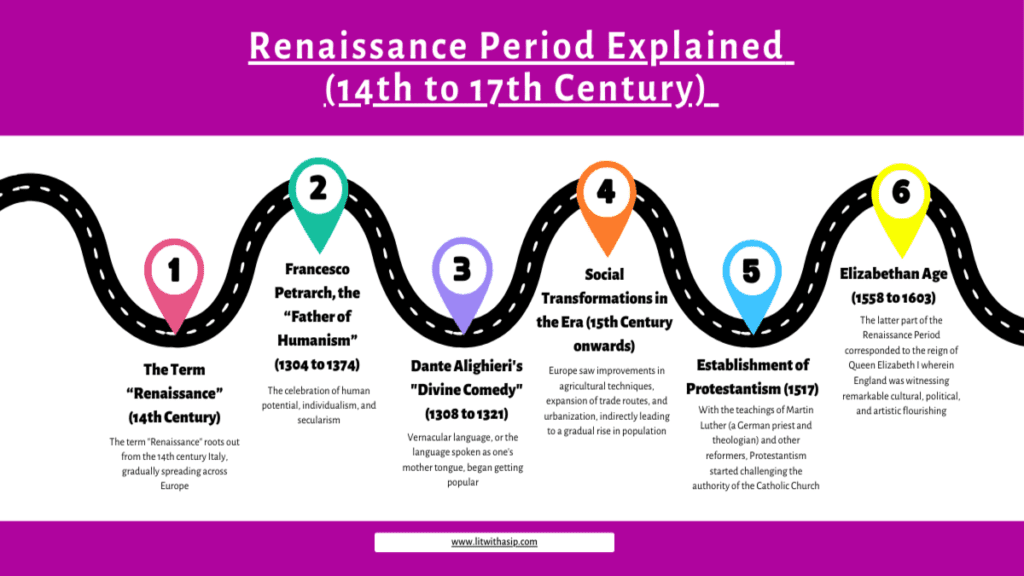
My partner and I stumbled over here from a different age and thought I should
check things out. I like what I see so now i’m following you.